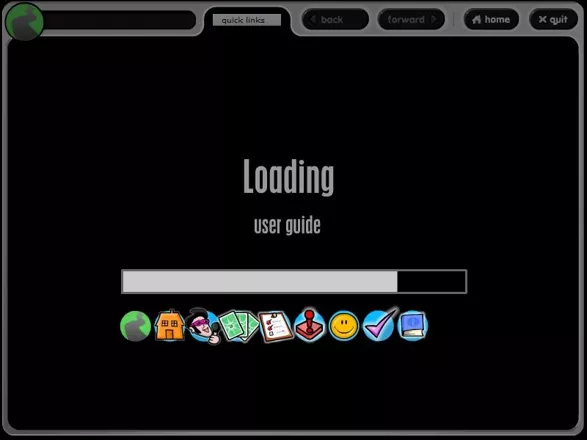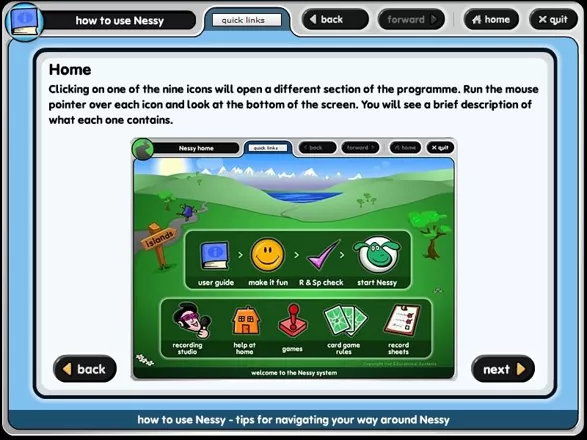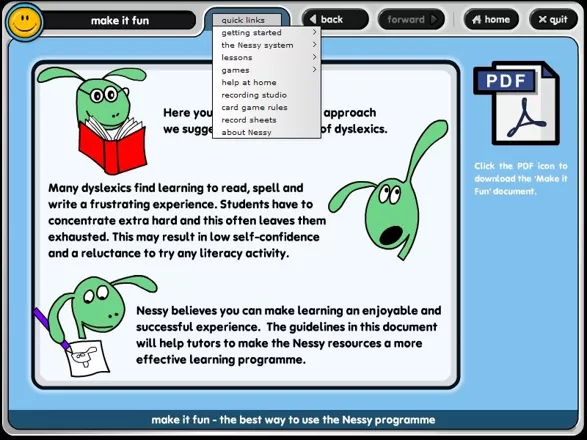The Nessy Learning Program
Description
The Nessy Learning Program is an educational system designed to help children with learning difficulties, especially those with dyslexia. It won numerous awards and was used in many schools in both the UK and the USA as well as being available for home use. As of 2017 The Nessy Learning Program as documented here has been replaced by a new on-line product set which still bears the name 'Nessy'.
The full system used both computer resources, traditional methods and board/card games to make learning fun. The computer games were based on a series of ten islands, which equate to ten levels, each named after a colour. Each island focused on a specific set of topics and used games to test the player's grasp of the concepts being taught, there were many topics on each island and only some of them had associated games. The Nessy Program had a standard set of games which are used throughout all levels of the program in different combinations, some topics may had a single game while others had several. While the games are the same throughout the program they used different sets of words that were appropriate to the topic this meant, for example, that the same game could help the player understand when to use the word endings 'k', 'ke, and 'ck' in one lesson while in another it helped the same player understand the different sounds made by the letters 'ough' as on cough, bough, bought etc.
The games used in this product are: Brain Drain: in this game the player is shown short sentence with a missing word and must select the appropriate word from four choices to complete the sentence correctly. It's played like Who Wants To be A Millionaire?* with 50/50, Ask Nessy, and Stop The Clock options. The more questions the player gets right the bigger their brain grows but it shrinks when they get one wrong.
-
Chase The Chicken: his is a Whack-A-Mole variant. The player is presented with a screen of eight hen houses and each house has a word above it. The game then says one of the eight words and the player must use the mouse to whack the right hen as it appears
-
Doggy Din Dins: the player is shown a grammatical rule of the type 'In case A do this, in case B do that' and is then presented with a series examples written on bones. The object of this game is to use the rule to decide to which of two dogs the bone should be fed.
-
Glynn Goes Fishing: Glynn sits in a fishing boat at the top right of the screen, there's a simple control to make him cast his line into the piranha infested lake. When a fish takes the bait the game pauses and 'says' a word which the player must then type in. If they type in the word correctly Glynn lands the fish.
-
Hands Off My Bananas: this is a two stage game featuring a monkey, two gorillas and a lot of bananas. In part one the game 'says' a word which the player must type in, every correct entry earns the monkey a coconut. In the second part of the game the monkey must defend his banana trees from two gorillas, it does this by throwing his coconuts at the gorillas to stop them eating his bananas.
-
House of Fear: this game turns the gaming concept of some of the other games on its head. The player is in a haunted house and is being chased by a monster, to escape they must find the correct path out of the house. Each screen has a different room but all rooms have four doors through which the player could go, above each doorway is a word, and at the top of the screen is a short sentence. If the player selects the correct word to complete the sentence they go through the portal and if they get enough answers correct they eventually escape.
-
Monster Words: tough words are referred to as Monster words, a typical example are words containing the letters 'ough'. After a brief introduction the player is shown all the possible sounds this combination of letters can make, they are then shown a word which they must read to decide which sound to select
-
Norman and His Horse: This is a short story in book form with animated sequences and a series of questions at the end.
-
Poke The Pig: this is essentially the same game as Chase The Chicken but instead of chickens in hen houses it has pigs in sties.
-
Power Protector: this game is used to teach word endings such as when to use 'dge' and when to use just 'ge'. The game explains the rule and then 'says' a word which the player must they type in. If they get it wrong a monster rushes from a cave and jumps all over their word, if they get it right the monster still rushes out but the correct spelling foils their destructive urge.
-
Silly Bull: this is a short animated sequence that explains syllables.
-
Squish 'Em: the flies are trying to eat the player's soup and to stop them the player uses the mouse to swat them. Every time the player swats a fly they hear a word which they must successfully type in to kill the fly, every incorrect answer sees the swarm get closer to the soup.
-
Wet Kipper: another two stage game this time featuring two penguins, Rocky and Kipper, where Rocky is trying to steal all of Kipper's fish. The game can be played as either character. As Kipper the player gets a snowball for every correct answer in part one which they can throw at Rocky in part two. Playing as Rocky the player gets fishbones in part one which they spit at Kipper in part two.
-
Whack A Rat: this is very similar to Squish 'Em, here a pack of rats are after a chunk of cheese, they keep running out from the holes in the skirting board and taking a chunk. The player whacks them by clicking on them with the mouse but only kills the rat if they correctly type in the word that's supplied.
Naturally 'The Nessy Learning Program' was more than just a set of games, there were lots of lessons, extensive teacher/parent notes, lots of information on dyslexia and links to Dyslexia sites. There was also a Word List Creator so that new lists could be created and added into the program, a Recording Studio so that pupils could hear themselves say words. On the website there were further educational products, a Nessy blog, links to free webinars and the history of how this product came to exist.
Screenshots
Analytics
Upgrade to MobyPro to view research rankings!
Identifiers +
Contribute
Are you familiar with this game? Help document and preserve this entry in video game history! If your contribution is approved, you will earn points and be credited as a contributor.
Contributors to this Entry
Game added by piltdown_man.
Game added June 14, 2017. Last modified March 9, 2023.




